A Study on Statistical Knowledge and Statistical Thinking of Twelfth Grade Students in Schools under the Office of the Secondary Educational Service Area in Bangkok
Keywords:
STATISTICAL KNOWLEDGE, STATISTICAL THINKING, STATISTICAL LITERACY, MATHEMATICAL KNOWLEDGEAbstract
The Purposes of this research were: 1) to study of the statistical knowledge of twelfth grade students; 2) to study of the statistical thinking of twelfth grade students; and 3) to find the relationship between statistical knowledge and statistical thinking of twelfth grade students. The sample of this study were 525 twelfth grade students in 15 schools under the office of the secondary educational service area in Bangkok. The research instruments were statistical knowledge test and statistical thinking test. The data were analyzed by arithmetic mean, percentage of arithmetic mean, standard deviation, t-test, correlation Simple Regression Analysis. The research finding were summarized as follows: 1) statistical knowledge of twelfth grade students was lower than the minimum criteria at a .05 level of significance which the average score was 39.30%; 2) statistical thinking of twelfth grade students was lower than the minimum criteria at a .05 level of significance which the average score was 43.44%; and 3) there was significant positive correlation between statistical knowledge and statistical thinking that statistical knowledge (x) could predict statistical thinking (X'Thinking) at 31.9% while the regression equations of raw score and standard score were as follows: X'Thinking = 6.457 + 0.773x and Y'Thinking = 0.565x respectively.
References
กระทรวงศึกษาธิการ. (2551). หลักสูตรแกนกลางการศึกษาขั้นพื้นฐาน พุทธศักราช 2551. กรุงเทพมหานคร: โรงพิมพ์ชุมนุมสหกรณ์การเกษตรแห่งประเทศไทย.
จิรรัตน์ จตุรานนท์. (2554). การศึกษาความรู้คณิตศาสตร์ ทักษะและกระบวนการทางคณิตศาสตร์ และความคิดเห็นเกี่ยวกับการเรียนการสอนของนิสิตนักศึกษาครุศาสตร์ ศึกษาศาสตร์ วิชาเอกคณิตศาสตร์ [วิทยานิพนธ์ปริญญามหาบัณฑิต]. Chulalongkorn University Intellectual Repository (CUIR). http://cuir.car.chula.ac.th/handle/123456789/32122
ทิศนา แขมมณี. (2547). ศาสตร์การสอน. สำนักพิมพ์แห่งจุฬาลงกรณ์มหาวิทยาลัย.
นริศรา โกเสนตอ. (2553). การใช้โครงงานคณิตศาสตร์เพื่อส่งเสริมการคิดเชิงสถิติของนักเรียนชั้นมัธยมศึกษา ปีที่ 3 โรงเรียนบ้านแม่คำ (ประชานุเคราะห์) อำเภอแม่จัน จังหวัดเชียงราย [วิทยานิพนธ์ปริญญามหาบัณฑิต ไม่ได้ตีพิมพ์]. มหาวิทยาลัยเชียงใหม่.
ประสงค์ เลิศสมบัติพลอย. (2553). การใช้โปรแกรมไมโครซอฟท์เอกซ์เซลเพื่อส่งเสริมการคิดเชิงสถิติ ของนักเรียนชั้นมัธยมศึกษาปีที่ 3 โรงเรียนบ้านห้วยต้ม จังหวัดลำพูน [วิทยานิพนธ์ปริญญามหาบัณฑิต ไม่ได้ตีพิมพ์]. มหาวิทยาลัยเชียงใหม่.
พิลาลักษณ์ ทองทิพย์. (2550). การศึกษาการให้เหตุผลทางสถิติของนักเรียนชั้นมัธยมศึกษาปีที่ 6 ในโรงเรียนสังกัดสำนักงานคณะกรรมการการศึกษาขั้นพื้นฐาน กรุงเทพมหานคร. จุฬาลงกรณ์มหาวิทยาลัย, กรุงเทพมหานคร [วิทยานิพนธ์ปริญญามหาบัณฑิต]. Chulalongkorn University Intellectual Repository (CUIR). http://cuir.car.chula.ac.th/handle/123456789/15419
สถาบันส่งเสริมการสอนวิทยาศาสตร์และเทคโนโลยี. (2559). สรุปผลการวิจัยโครงการ TIMSS 2015. https://drive.google.com/file/d/0Bza8voFmdFsrRGlYbmdPa0pkXzg/view
สถาบันส่งเสริมการสอนวิทยาศาสตร์และเทคโนโลยี. (2561). สรุปผลการวิจัย PISA 2015. https://drive.google.com/file/d/0BwqFSkq5b7zScUJOOV9ldUNfTlk/view
สถาบันทดสอบทางการศึกษา. (2561). สรุปผลการทดสอบทางการศึกษาระดับชาติขั้นพื้นฐาน (O-NET) ชั้น มัธยมศึกษาปีที่ 6 ปีการศึกษา 2561. http://www.newonetresult.niets.or.th/AnnouncementWeb/PDF/SummaryONETM6_2561.pdf
อัมพร ม้าคนอง. (2554). ทักษะและกระบวนการทางคณิตศาสตร์: การพัฒนาเพื่อพัฒนาการ. ศูนย์ตำราและเอกสารทางวิชาการ คณะครุศาสตร์ จุฬาลงกรณ์มหาวิทยาลัย.
Berg, C. A., & Phillips, D. G. (1994). An investigation of the relationship between logical thinking structures and the ability to construct and interpret line graphs. Journal of Research in Science Teaching, 31(4), 323-344.
DelMas, R. (2002). Statistical literacy, reasoning, and learning. Journal of Statistics Education. 10(3). http://doi.org/10.1080/10691898.2002.11910679
Goetz, T., & Hall, N. C. (2013). Emotion and achievement in the classroom. In J. Hattie, & E. M. Anderman (Eds.). International guide to student achievement (pp. 192-195). Taylor & Francis.
Jaleel, S. (2015). Relationship between mathematical thinking and achievement in mathematics among secondary school students. Pariex-Indian Journal of Research. 4(11), 19-21. https://www.worldwidejournals.com/paripex/fileview/November_2015_ 1449045911__07.pdf
Langrall, C. W., & Mooney, E.S. (2002). The development of a framework characterizing middle school students’ statistical thinking. The Sixth International Conference on Teaching Statistics. https://www.stat.auckland.ac.nz/~iase/publications/1/6b3_lang.pdf
MacGillivray, H., & Mendoza, L. P. (2011). Teaching statistics through investigative projects. In C. Batanero, G. Burrill, & C. Reading (Eds.), Teaching statistics in school mathematics-challenges for teaching and teacher education (pp. 109-120). Springer.
Nepal, B. (2016). Relationship between mathematical thinking and Mathematics achievement. IOSR Journal of Research & Method in Education, 6(6), 46-49.
Noll, J. (2007). Graduate Teaching Assistants’ Statistical Content Knowledge of Sampling. Statistics Education Research Journal, 10(2) 48-74.
Padilla, M. J., McKenzie, D.L., & Shaw, E.L. (1986). An examination of the line graphing ability of students in grades seven through twelve. School Science and Mathematics, 86(1), 20-26.



